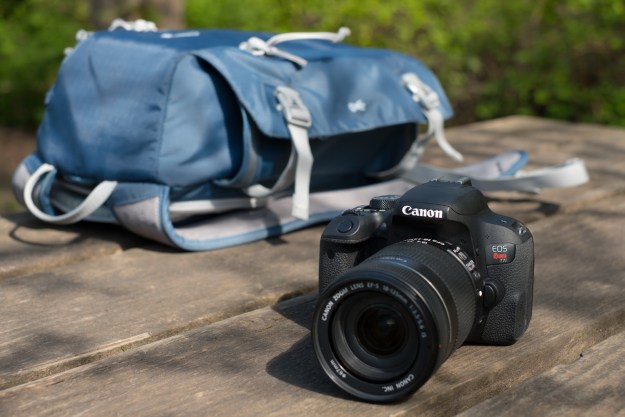For its Photokina 2014 announcements, Canon unveiled not only its latest prosumer APS-C camera, the EOS 7D Mark II, but also a much smaller, yet no less intriguing device. It’s called the PowerShot G7 X, and while by name a member of the G-series family, it actually more closely resembles the PowerShot S120 rather than its bigger cousin, the G1 X Mk II.
Compared to either of these two cameras, the G7 X is noticeably different. While it has roughly the same form factor as the S120 – being only a tad thicker – the G7 X comes with both a larger 1-inch-type sensor and a brighter lens, at the expense of a bit of telephoto zoom capability. The G1 X Mk II, on the other hand, is much bigger than the G7 X, but then again that has a larger APS-C sensor and a more powerful yet slightly slower zoom lens. The G7 X, thus, sits neatly in-between these two cameras and combines the best of both the S-series and the G-series models.
Specifications wise, the G7 X comes with a 20-megapixel 1-inch sensor. This seems to be a rising trend in compact cameras, and there are a lot of benefits to implementing a sensor of this size into a camera that’s a small package while still providing very good overall image quality. The lens on the G7 X is a 4.2x, 24-100mm equivalent zoom lens with an initial aperture ranging from f/1.8 at the wide-angle end to f/2.8 at the telephoto end. This gives it an edge over both the G1 X Mk II and the S120, which max out at f/3.9 and f/5.7 respectively. The lens also makes the G7 X the more attractive choice over any of Sony’s RX100-series models, with the original RX100 and the RX100 Mk II having a widest aperture of f/4.9 at their 100mm-equivalent zoom settings, and the RX100 Mk III‘s lens extending only as far as 70mm.

Around the lens, the G7 X has the same function ring that we’ve come to know not only from the S-series, but also from many other contemporary camera models. It can be set to fulfill a number of different functions pertaining not only to lens settings. On the top of the camera, there’s not only a mode dial but also an exposure compensation dial – something that the G1 X Mk II lacks entirely, despite it being part of the G-series which have historically put a focus on featuring as many direct settings options as possible. The rear of the camera is very similar in terms of buttons and dials to both the G1 X Mk II and the S120, with the new 1-million-dot, 180-degree tilting 3-inch screen being the most prominent feature.
Speaking of the G7 X’s screen, thanks to its 180-degree tilting mechanism it can be flipped upward all the way until it becomes a virtual “mirror,” letting you check your hair or make-up or snap a quick selfie (or group shot) without having to guess the framing. Displays that can be flipped to face forward are nothing new, but they used to be very rare and have never been advertised as aggressively as these days, where the selfie craze is driving manufacturers to include features that facilitate taking pictures of one’s self.
Related: Canon evolves EOS 7D DSLR with Mark II, adds new lenses, compact cameras
Unlike Panasonic’s new Lumix LX100 compact, the Canon G7 X isn’t capable of recording 4K video, concentrating instead on Full HD. Reserving 4K capability for its high-end cine cameras seems to be Canon’s strategy right now, and it may take a little longer until we see the new video standard implemented in consumer cameras. The G7 X records Full HD video in the H.264 format, supporting frame rates of either 30p or 60p. If you’re a fan of the cinematic look that 24 frames-per-second yields, the G7 X may not be the camera for you.

During Photokina, we were able to play a bit with a G7 X but were unable to put an SD card into a camera, so we can’t comment on its image quality yet. Considering, however, that the camera’s sensor resolves the same 20 megapixel as many other current 1-inch models, it is easy to imagine what images coming out of the G7 X will look like. What we can comment on is the autofocusing, which seemed very fast and accurate during our quick test.
In the hand, the G7 X is a typical compact camera, and it is very similar to both the Canon S120 and Sony’s RX100 series. The selfie-friendly display is a neat addition, but we would’ve wished that it could also be tilted downward, as over-the-head shots with the G7 X are hardly possible this way. As for ergonomics, we reckon that the G7 X will be a little too small for large hands, especially considering the lack of a pronounced grip at the front (there is, however, a small thumb rest at the back.) In terms of “pocketability,” the G7 X is a definitive winner as it packs a huge amount of punch in a body that fits in your trouser pocket.
The G7 X will be available this October for about $550, which gives it a very attractive price-performance ratio and will make many potential buyers of the Sony RX100 (Mark II/III) think twice.


